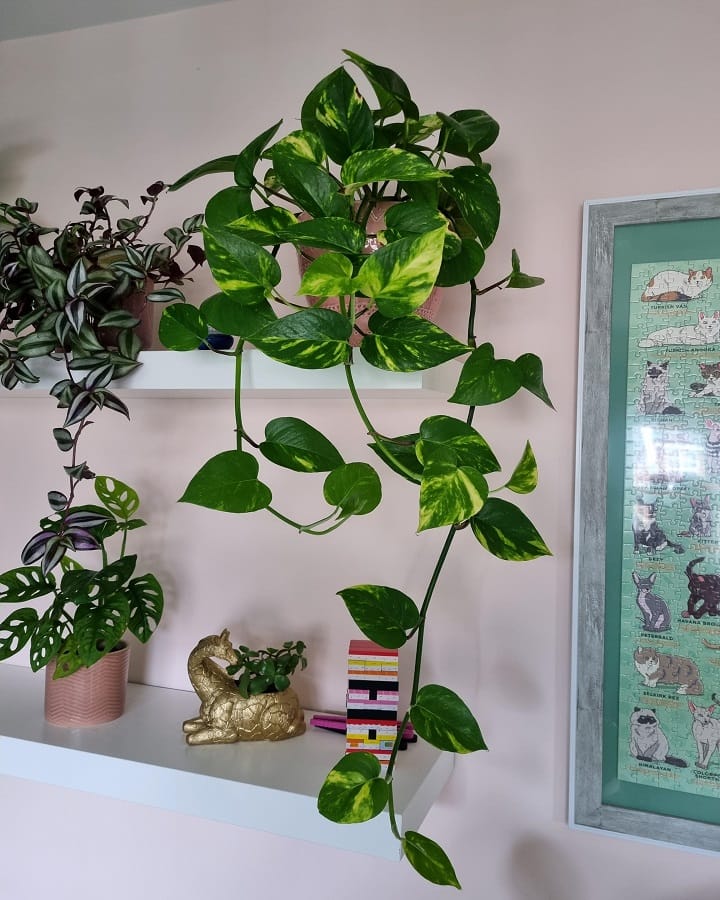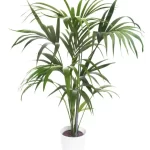
Image Credit- Hema
Devils Ivy Plant Care is often praised for being low-maintenance, making this trailing vine a favorite among houseplant enthusiasts and beginners alike. Also known as pothos or Epipremnum aureum, Devil’s Ivy thrives in a range of indoor environments. However, even this hardy plant can show signs of stress—most commonly through yellowing leaves. Understanding the essentials of Devils Ivy Plant Care is key to keeping your plant lush, green, and healthy year-round. In this guide, we’ll explore the causes of yellow leaves and how to fix them with simple, effective care tips.
Ultimate Devils Ivy Plant Care

Why Are the Leaves Turning Yellow?
Yellow leaves are a clear signal that your plant is under stress. Here’s how to identify the cause and take corrective action:
1. Overwatering
The problem:
Overwatering is the most common reason for yellow leaves on Devil’s Ivy. When the soil stays too wet for too long, roots begin to rot, preventing the plant from absorbing nutrients properly.
The fix:
Let the top 1–2 inches of soil dry out before watering again. Always use a pot with drainage holes and avoid letting the plant sit in standing water.
Pro tip: Stick your finger into the soil or use a moisture meter to check the moisture level before watering.
2. Underwatering
The problem:
On the flip side, underwatering can also cause leaves to yellow and curl. Devil’s Ivy needs consistent, moderate watering to thrive.
The fix:
Water thoroughly when the soil feels dry, but don’t wait until the plant is bone dry. A good rule is to water every 7–10 days, depending on your indoor climate.
3. Poor Lighting
The problem:
Devil’s Ivy can survive in low light, but insufficient light over time can lead to pale or yellowing leaves.
The fix:
Place your plant in bright, indirect sunlight. Avoid harsh, direct rays which can scorch the leaves, but make sure the plant isn’t sitting in a dark corner either.
4. Nutrient Deficiency
The problem:
A lack of essential nutrients, especially nitrogen, can cause older leaves to turn yellow.
The fix:
Use a balanced, water-soluble houseplant fertilizer every 4–6 weeks during the growing season (spring through early fall). Be careful not to over-fertilize, as this can cause chemical burn and lead to more yellowing.
5. Pests
The problem:
Spider mites, mealybugs, and scale insects can damage leaves and cause discoloration.
The fix:
Inspect the undersides of leaves and stems for tiny bugs. Wipe the plant with a damp cloth, spray with insecticidal soap, or use neem oil to get rid of pests naturally.
6. Natural Aging
The problem:
Sometimes, yellow leaves are just part of the plant’s natural growth cycle. Older leaves near the base will occasionally yellow and drop off.
The fix:
If the plant is otherwise healthy and it’s only one or two lower leaves turning yellow, there’s likely nothing to worry about. Simply prune them off.
Devil’s Ivy Plant Care Best Practices
To keep your plant happy and avoid future yellowing, follow these basic Devil’s Ivy plant care tips:
- Water: Allow the top inch of soil to dry out before watering.
- Light: Provide bright, indirect light for best growth.
- Humidity: Moderate humidity levels are ideal; mist occasionally or place near a humidifier.
- Soil: Use a well-draining potting mix with perlite or peat moss.
- Fertilizer: Feed monthly during the growing season.
- Pruning: Trim vines and remove dead leaves to encourage fuller growth.
If your Devil’s Ivy is root-bound (roots growing out of drainage holes or circling the pot), it might be time to repot. Choose a pot one size larger and refresh the soil to give the roots room to breathe and absorb nutrients more efficiently.
Yellow leaves on your Devil’s Ivy may seem alarming, but they’re usually a sign that your plant just needs a bit of adjustment. Whether it’s too much water, not enough light, or a lack of nutrients, identifying the issue early will help your plant bounce back quickly. With proper Devils Ivy plant care, your pothos can thrive for years—greener, healthier, and more beautiful than ever.
Yellowing leaves may seem like a big problem, but with proper Devils Ivy Plant Care, it’s usually an easy fix. A few simple changes to your watering habits, light exposure, and feeding schedule can make a big difference. Stick to a consistent care routine, and your plant will thrive with vibrant green growth. Have you experienced yellowing leaves on your Devil’s Ivy? Let us know in the comments how you fixed it—we’d love to hear your care tips and success stories!
Frequently Asked Questions
What are the basics of Devils Ivy plant care?
Devils ivy plant care includes moderate watering, bright indirect light, and occasional feeding. Let the topsoil dry between waterings to avoid yellow leaves and root rot.
How do I fix yellow leaves with proper Devils Ivy Plant Care?
Yellow leaves often signal overwatering, low light, or nutrient issues. With proper Devils Ivy Plant Care—adjusting water, light, and feeding—you can restore healthy foliage.
Is Devils Ivy Plant Care easy for beginners?
Yes! Devils Ivy Plant Care is beginner-friendly. It’s a hardy plant that thrives in various indoor conditions with just basic watering, light, and pruning routines.







